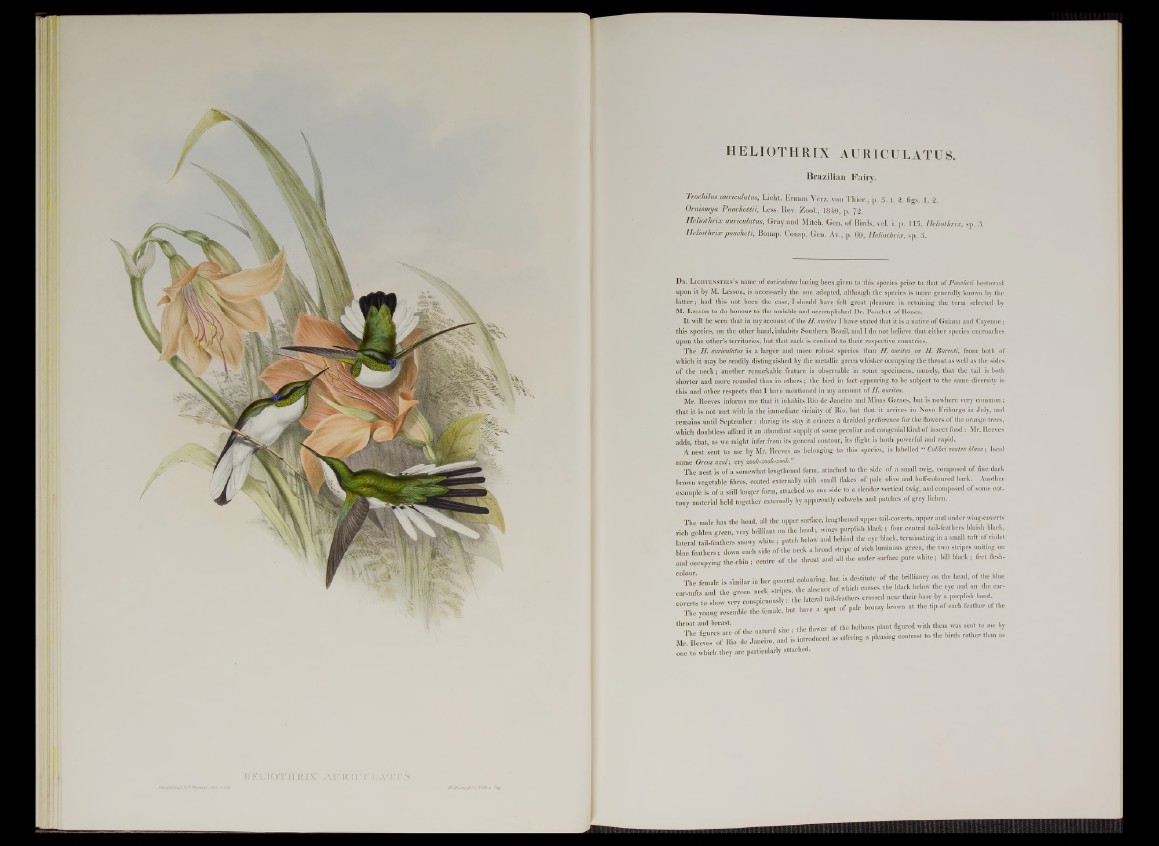
HELIOTHRIX AURICULATUS.
Brazilian Fairy.
Trochilus auriculatus, Licht. Erman Verz. von Thier., p. 5. t. 2. figs. 1, 2.
Ornismya Poiichettii, Less. Rev. Zool., 1840, p. 72.
H e lio th rix auriculatus, Gray and Mitch. Gen. of Birds, vol. i. p. 115, Heliothrix, sp. 3.
H elio th rix poucheti, Bonap. Consp. Gen. Av., p. 69, Heliothrix. sp. 3.
Dr. L ichtenstein’s name of auriculatus having been given to this species prior to that of Poucheti bestowed
upon it by M. Lesson, is necessarily the one adopted, although the species is more generally known by the
la tte r; had this not been the case, I should have felt great pleasure in retaining the term selected by
M. Lesson to do honour to the amiable and accomplished Dr. Pouchet of Rouen.
It will be seen that in my account of the H auritus I have stated that it is a native of Guiana and Cayenne;
this species, on the other hand, inhabits Southern Brazil, and I do not believe that either species encroaches
upon the other’s territories, but that each is confined to their respective countries.
The H. auriculatus is a larger and more robust species than H. auritus or H Barroti, from both of
which it may be readily distinguished by the metallic green whisker occupying the throat as well as the sides
of the neck; another remarkable feature is observable in some specimens, namely, that the tail is both
shorter and more rounded than in others; the bird in fact appearing to be subject to the same diversity in
this and other respects that I have mentioned in my account of H. auritus.
Mr. Reeves informs me that it inhabits Rio de Janeiro and Minas Geraes, but is nowhere very common ;
that it is not met with in the immediate vicinity of Rio, but that it arrives in Novo Friburgo in July, and
remains until September : during its stay it evinces a decided preference for the flowers of the orange trees,
which doubtless afford it an abundant supply of some peculiar and congenial kind of insect food: Mr. Reeves
adds, that, as we might infer from its general contour, its flight is both powerful and rapid.
A nest sent to me by Mr. Reeves as belonging to this species, is labelled “ Colibrí ventre blanc; local
name Oreus azul', cry zook-zook-zook.”
The nest is of a somewhat lengthened form, attached to the side of a small twig, composed of fine dark
brown vegetable fibres, coated externally with small flakes of pale olive and buff-coloured bark. Another
example is of a still longer form, attached on one side to a slender vertical twig, and composed of some cot-
tony material held together externally by apparently cobwebs and patches of grey lichen.
The male has the head, all the npper surface, lengthened upper tail-coverts, upper and under wing-corerts
rich golden green, very brilliant on the head; wings purplish black ; four central tail-feathers bluish black,
lateral tail-feathers snowy white ; patch below and behind the eye black, terminating in a small tuft of violet
blue feathers; down each side of the neck a broad stripe of rich luminous green the two stripes uniting on
and occupying the-chin ; centre of the throat and all the under surface pure white; bill black ; feet flesh-
C°The" female is similar in her general colouring, hut is destitute M B M ™ the head, of the blue
1 ft. .„ a the vreen neck stripes, the absence of which causes the black below the eye and on the ear-
ear-tufts a g lateral tail-feathers crossed coverts to show very conspicuously: the lateral laiiieaincto w near their base by a purp‘ lish .b and.f .
The young resemble the female, but have a spot of pale bronzy brown at the tip of each feather of the
throat and breast. ■ H fte plant figured with them was sent to me by
de Janeiro, and is introduced as oifering a pleasing contrast to the birds rather than as